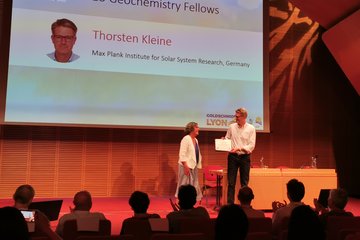Alle Typen
21.
Zeitschriftenartikel
Structure and evolution of the diamagnetic cavity at comet 67P/Churyumov-Gerasimenko. Mon. Not. Roy. Astron. Soc. 462, S. S459 - S467 (2016)
22.
Zeitschriftenartikel
Attitude reconstruction of ROSETTA's Lander PHILAE using two-point magnetic field observations by ROMAP and RPC-MAG. Acta Astronaut. 125, S. 174 - 182 (2016)
23.
Zeitschriftenartikel
Magnetic field pile-up and draping at intermediately active comets: results from comet 67P/Churyumov-Gerasimenko at 2.0 AU. Mon. Not. Roy. Astron. Soc. 462, S. S235 - S241 (2016)
24.
Zeitschriftenartikel
Low-frequency waves at comet 67P/Churyumov-Gerasimenko Observations compared to numerical simulations. Astronomy and Astrophysics 594, A66 (2016)
25.
Zeitschriftenartikel
Modified ion-Weibel instability as a possible source of wave activity at Comet 67P/Churyumov-Gerasimenko. Annales Geophysicae 34 (9), S. 691 - 707 (2016)
26.
Zeitschriftenartikel
The influence of resistivity gradients on shock conditions for a Petschek reconnection geometry. Annales Geophysicae 34 (4), S. 421 - 425 (2016)
27.
Zeitschriftenartikel
Wave-particle resonance condition test for ion-kinetic waves in the solar wind. Annales Geophysicae 34 (4), S. 393 - 398 (2016)
28.
Zeitschriftenartikel
On Electron-Scale Whistler Turbulence in the Solar Wind. Astrophysical Journal 827 (1), L8 (2016)
29.
Zeitschriftenartikel
Ion Bernstein waves in the magnetic reconnection region. Annales Geophysicae 34 (1), S. 85 - 89 (2016)
30.
Zeitschriftenartikel
Wave telescope technique for MMS magnetometer. Geophysical Research Letters 43 (10), S. 4774 - 4780 (2016)
31.
Zeitschriftenartikel
Observational Test for a Random Sweeping Model in Solar Wind Turbulence. Physical Review Letters 116 (12), 125101 (2016)
32.
Zeitschriftenartikel
The nonmagnetic nucleus of comet 67P/Churyumov-Gerasimenko. Science 349, aaa5102 (2015)
33.
Zeitschriftenartikel
Solar wind reconstruction from magnetosheath data using an adjoint approach. Annales Geophysicae 33 (12), S. 1513 - 1524 (2015)
34.
Zeitschriftenartikel
A statistical study of fundamental toroidal mode standing Alfven waves using THEMIS ion bulk velocity data. Journal Geophysical Research 120 (8), S. 6474 - 6495 (2015)
35.
Zeitschriftenartikel
Multifrequency compressional magnetic field oscillations and their relation to multiharmonic toroidal mode standing Alfven waves. Journal Geophysical Research 120 (12), S. 10384 - 10403 (2015)
36.
Zeitschriftenartikel
Spatial and temporal dependence of the convective electric field in Saturn's inner magnetosphere. Icarus 229, S. 57 - 70 (2014)
37.
Zeitschriftenartikel
Multi-Spacecraft Observations of Linear Modes and Sideband Waves in Ion-Scale Solar Wind Turbulence. Astrophysical Journal 793 (2), L25 (2014)
38.
Zeitschriftenartikel
A new method for solving the MHD equations in the magnetosheath. Annales Geophysicae 31 (3), S. 419 - 437 (2013)
39.
Zeitschriftenartikel
Doppler shift and broadening in solar wind turbulence. Earth, Planets and Space 65 (1), S. E5 - E8 (2013)
40.
Zeitschriftenartikel
Ionospheric response to oscillatory flow braking in the magnetotail. Journal Geophysical Research 118 (4), S. 1529 - 1544 (2013)











